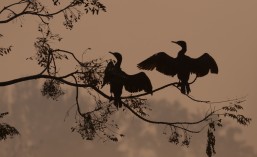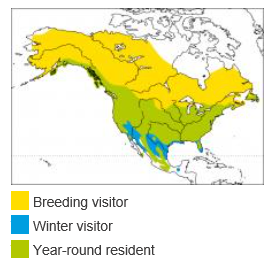Order: Passeriformes Family: Turdidae Conservation Status: Least Concern
Synonyms: San Lucas Robin
Description:
The American Robin is a medium-sized thrush, typically weighing about 77 g and measuring 23 to 28cm in length with a wingspan of 31 to 41 cm. The colour of the head varies from jet black to grey with white eye arcs and white supercilia, blackish lores and a black lateral throat stripe. The throat, belly and under-tail are white, although the throat is streaked black. The back is brown whilst the breast is reddish-orange. The tail is blackish with white corners. The sharp bill is typically yellow with a variable dark tip which becomes more extensive in winter. The legs and feet are brown.
There is very little sexual dimorphism in adult birds; the female is slightly smaller and appears duller than the male, with a brown tint to the head and more buff-coloured white areas.
Juvenile birds appear as pale versions of adult males and have dark spots on their breast, pale spots and streaks on their upperparts, an entirely white throat and a pinkish beak.
Call and Vocalisation:
The American Robin is amongst the first birds to sing at dawn. During the breeding season the male bird has a complex and almost continuous song made up of discrete, yet repeated, units. This song varies regionally and also varies throughout the day. ssp. confinis has a weaker song which lacks any clear notes. A typical song is described as “cheerily, cheer up, cheer up, cheerily, cheer up”.
In addition to the courting song, American Robins use various other calls for communication such as “chirping” or “chucking” when a roost or nest is under threat from a predator, or when a storm is passing.
American Robin song
American Robin alarm call
Range and Distribution:
The American Robin is one of the most abundant land birds in North America and is widely distributed. It breeds from Alaska and Canada, south to northern Florida and Mexico. Most birds are migratory and winter in Florida, the Gulf Coast, Central Mexico and along the Pacific Coast. Some birds will occasionally overwinter in the northern US states and southern Canada.
There are seven recognized subspecies, although hybridization is common and distinctions between races are weak;
ssp. migratorius – The nominate race breeds at the edge of the tundra from Alaska and northern Canada east to New England and south to Maryland, northwest Virginia, and North Carolina. It winters in southern coastal Alaska, southern Canada, most of the US, Bermuda, the Bahamas and eastern Mexico.
ssp. nigrideus – Breeds from coastal northern Quebec to Labrador and Newfoundland and winters from southern Newfoundland south through most of the eastern US states to southern Louisiana, southern Mississippi and northern Georgia. Compared to the nominate race this sub species is uniformly darker or blackish on the head, with a dark grey back and its’ underparts are slightly more red.
ssp.achrusterus – Breeds from southern Oklahoma, east to Maryland and western Virginia and south to northern Florida and the Gulf states. It winters through much of the southern part of the breeding range. Compared to the nominate race it is smaller, the black feathers of the forehead and crown have pale grey tips and the underparts are paler.
ssp. caurinus – Breeds in southeast Alaska through coastal British Columbia to Washington and northwest Oregon. It winters from southwest British Columbia south to central and southern California and east to northern Idaho. Compared to the nominate subspecies it is very slightly smaller with a very dark-head. Also, the white on the tips of the outer tail feathers is restricted.
ssp. propinquus – Breeds from southeast British Columbia, southern Alberta, southwest Saskatchewan south to southern California and northern Baja California. It winters throughout much of the southern breeding range and south to Baja California. It is roughly the same size as the nominate race, but its overall appearance is paler and tinged more heavily brownish-grey. There is very little white on the tip of the tail feather. Females of this subspecies lack almost any red below, whilst males are darker and may show pale or whitish sides to the head.
ssp.confinis – Breeds in the highlands of southern Baja California. This race is particularly distinctive, having pale grey-brown underparts and a uniform pale grey-brown on the head, face and upperparts. It usually lacks any white spots to the tips of the outer tail feathers, which have white edges.
ssp. phillipsi – Resident in Mexico south to central Oaxaca. It is slightly smaller than ssp. propinquus but has a larger bill. The underparts of the male are less brick-red than the nominate subspecies with a rustier tone.
The American Robin is a rare vagrant to Western Europe, where it sporadically can be seen in Britain (ssp. migratorius), usually as a result of migration displacements. Other vagrant birds have been recorded in Greenland and Iceland (ssp. nigrideus), Jamaica, Puerto Rico and Belize (ssp. achrusterus).
Habitat:
American Robins populate and breed in a wide variety of habitats from urban areas, such as gardens and parks, to woodlands, forests, shrub land, fields, farmlands, mountains and tundra. Winter months tend to be spent at lower elevations in more open habitat with a reliable food supply. They can often be seen searching for food in open ground or short grass or nesting and roosting in woodland and shrubs.
Diet:
The American Robin has a varied, omnivorous diet. In spring and summer they primarily eat small invertebrates, and in autumn and winter they mostly eat fruits and berries. It is this ability to switch diets which enables the American Robin to winter much further north than many other species of thrush.
Earthworms are an important staple in their diet and the American Robin can often be seen hunting on lawns. They run and pause, using their eyesight to locate worms, and then pull them from the ground. Additionally American Robins also eat beetles, caterpillars, grasshoppers, spiders, snails and on occasion small shrews or snakes. Commonly eaten fruits and berries include juniper, dogwood, sumac and chokecherries. The diet is typically 40% insects and 60% fruits and berries.
American Robins flock to fermented Pyracantha berries. If they eat sufficient quantities they can show signs of intoxication, such as falling over whilst walking.
Occasionally the American Robin may visit bird feeders, especially in a harsh winter if meal-worm or animal-fat suet is offered.
When being cared for by their parents, young birds are mostly fed earthworms and insects.
Whilst American Robins get the majority of their moisture needs from their food they can often be found drinking standing water.
Breeding:
The breeding season lasts from April to July and two to three broods will normally be hatched each year. The male will arrive first at the nesting ground and create and defend his territory by singing and fighting off competitive males. In addition to his singing, the male’s courtship display also involves raising and spreading his tail, shaking his wings and inflating his throat. Once attracted, the female will select a suitable nesting location and then singly construct a nest in the horizontal fork of two branches up to 4.5 m off the ground. The nest is a cup made from coarse grass, twigs, paper and feathers and is lined with mud and fine grass. Nests are also built in eaves and awnings if they provide sufficient shelter.
Each brood consists of a clutch of three to five pale blue eggs. The female incubates the eggs for 12 to 14 days before hatching. After a further two weeks the chicks fledge the nest. They are capable of short flight at this time but will continue to be fed by the parents for a further two weeks, at which point the chicks become capable of sustained flight.
Both parents will actively protect and feed the fledged chicks until they can fend for themselves. Adult birds will dive-bomb dogs, cats, humans and any other perceived threat that gets too close to the chicks.
It has been determined that only 25% of fledglings survive the first year, with the average lifespan of the American Robin being two years.
Behaviour:
American Robins are highly social birds, especially in winter when they roost in large flocks which disperse during the day to form feeding parties. During the breeding season they become less social as they begin to claim and defend territories.
Conservation Status:
The American robin has an estimated population of about 320 million birds and covers an extensive range of 16 million square kilometres with growing populations and is therefore considered to be of least concern. Historically, in some Southern States, the bird was killed for its meat, but it is now protected by the Migratory Bird Act.
Due to its habit of foraging on lawns and fields, the American Robin is very susceptible to the effects of pesticides, which can kill the bird directly or reduce its breeding success. One recorded incident in Florida in 1972 saw the death of 10,000 birds as a direct result of pesticide application. Due its widespread nature, easy recognition and ease at being near humans, deaths of American Robins are readily observed and can serve as an indicator of a wider environmental issues.
The hatchlings and eggs of the American Robin are preyed upon by squirrels, snakes and other birds, whilst adult birds are preyed upon by hawks, cats and large snakes. When feeding in flocks, sentry birds will watch for predators and alert the flock to danger. The Brown-headed Cowbird (Molothrus ater) is a brood parasite for the American Robin, however adults usually reject the cowbird egg from the nest.
The American Robin is a known carrier of West Nile virus and is suspected of being a key host in the transmission of the disease to humans. It is capable of surviving the effects of the virus longer than most other species of bird and as a result is more likely to transmit the virus to mosquitoes which in turn transmit the virus to humans.

